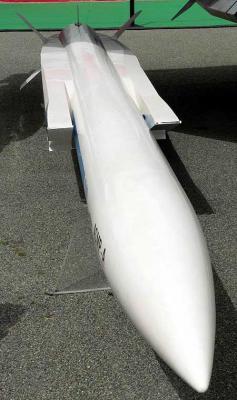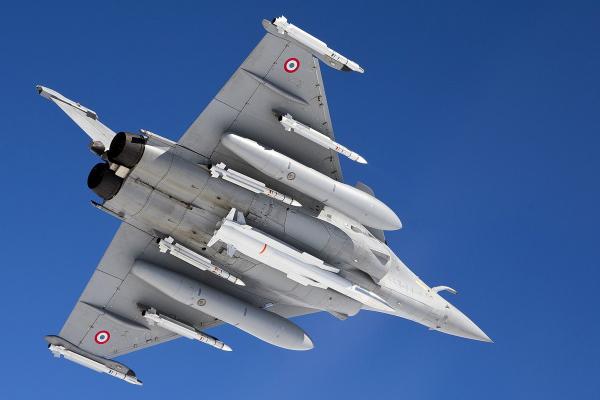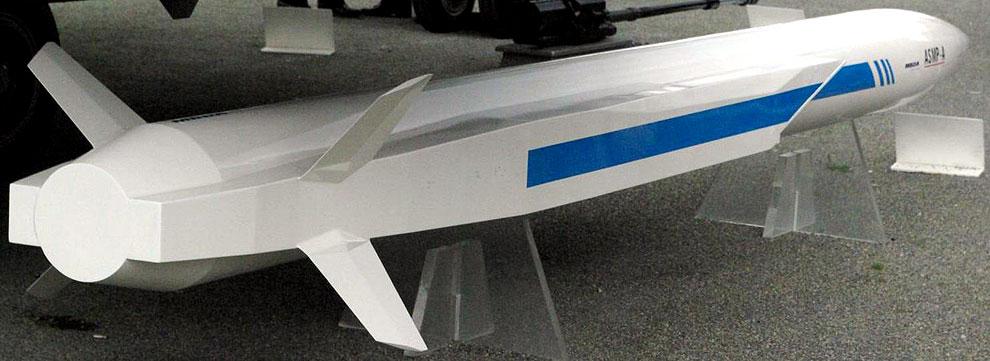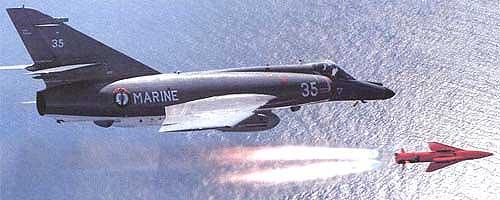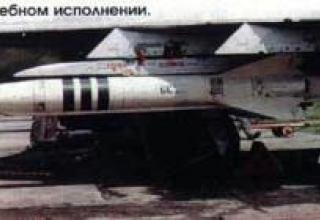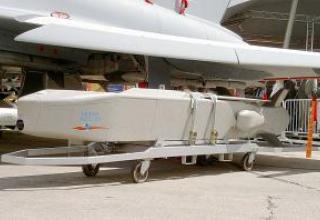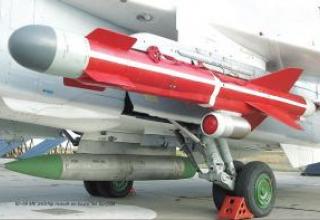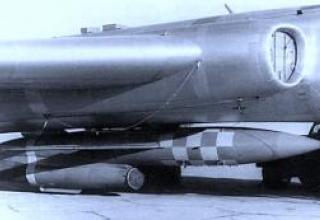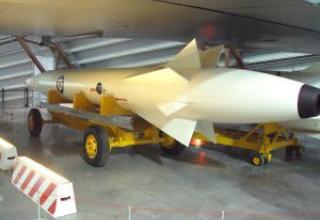Work on the development of missile weapons with a powerful nuclear or thermonuclear BC, suitable for placement on strategic aircraft carriers, began in France in the late 1960s under the leadership of the company "Aerospatiale". In 1970 it was decided to start research and development on creation of perspective ALCM with thermonuclear BC, the first missile was to be produced no later than 1974. However in 1971, on the wave of successes achieved in the process of creation of MRBMs and SSBNs/ SSBNs, the problem seemed to have lost its urgency and the program of creation of such aircraft-based weapons was closed. However, in the second half of the 1970s, the French top military leadership became aware of the growing role of strategic aviation in a possible limited war, especially on the European TVD. In this case, neither MRBMs nor SLBMs could accomplish the necessary tasks, and Air Force aircraft (primarily Mirage-IVA medium-range strategic supersonic bombers) equipped with free-falling nuclear bombs of relatively low power (the most powerful, AN-22, had a power of no more than 70 kt and a mass of about 750 kg) were too vulnerable to air defense. Therefore, in 1977. Technical Department of the Ministry of Defense of the country issued an appeal to the leading aerospace companies of the country with the call to study the current situation and find the answer to new challenges. According to the results of the contest, the concept of "Aerospatiale Matra" corporation was recognized as the best concept.
The company started to develop a promising short-range thermonuclear missile in 1978, focusing as a carrier on the newest multi-purpose tactical supersonic aircraft "Mirage-2000", which was then under development and testing. The new missile was named ASMP ("Air-Sol Moyenne Portee" - a medium-range "air-to-ground" missile). SNPE was the developer of the propulsion system for the new missile. The division "Direction des Affaires Militaires" of the civil authority "Commissariat a l'Energie Atomique" was responsible for the production of the combat unit. The launch range of the ASMP missile was to allow for a strike against a selected target without the bomber entering the air defense zone of the target. The new missile had to become resistant to PFC, have a significant speed and high maneuverability, have a sufficiently powerful BC and high accuracy.
However, due to a delay in the creation of a new aircraft carrier, in 1979 it was decided to equip missiles ASMP primarily existing strategic supersonic bombers "Mirage-IVA" (with upgrading them to the level of "Mirage-IVP"). In 1980, it was also approved the concept of equipping these missiles light attack deck aircraft "Super Etandard", based on two multi-purpose aircraft carriers available in France, type "Clemenceau". Deck aircraft were to use new weapons not only against ground targets, but also against large surface groups of the Soviet Navy, the power of which after the introduction of heavy aircraft carriers and missile cruisers began to worry NATO analysts.
The serial production of new missiles began at the end of 1983, the first missiles entered the operational units in September 1985... The ASMP missile was officially adopted in 1986, when it was equipped with "Mirage-IVP" 91st strategic bomber squadron (May - 1st squadron, Mont-de-Marsan air base; December - 2nd squadron, Cazo air base, a total of 18 aircraft). The newest aircraft "Mirage-2000N" (N - from "nucleaire", ie special strategic "nuclear" modification, with a crew of 2 people and special electronics, especially resistant to PFN and allows you to make a long supersonic flight at low altitude with following the terrain) received the first rockets in July 1988, and "fleet" Super Etandard - in June 1989. For the basing of the modified aircraft "Super Etandard" was modernized, however, only one of the two available aircraft carriers - "Foch" (11th Navy Aviation Flotilla).
All manufactured ASMP missiles were upgraded in the period 1987-1991, when the TN-80 thermonuclear BC was replaced by an improved, lighter, safer and PFC-resistant BC TN-81 of the same capacity (the replacement was made by upgrading the TN-80 BC). In order to improve the attack aviation capabilities in the first half of the 1980s, France also purchased from the U.S. strategic air tankers KC-135F "Stratotanker" adapted to French conditions, which began to perform tasks in 1985.
In 1996, among the ASMP missile carriers were excluded aircraft "Mirage-IVP", transferred to the category of strategic scouts (in 2005, finally removed from service). At the same time, the ASMP missile should receive the latest supersonic multi-purpose aircraft "Rafale-B / C" (double / single attack option for the Air Force) and "Rafale-M" (single deck attack option for the Navy). Deck carriers are to be placed on Charles de Gaulle nuclear multipurpose aircraft carriers. KC-135FR and French strategic air tankers KC-135F "Stratotanker" have been upgraded to the level of KC-135F - the improved vehicles have the ability to transfer at refueling by 50% more fuel with the same range.
In the 90s, after the collapse of the IAB and the USSR, the probability of armed conflict in Europe decreased dramatically. However, despite this, France has been steadily improving the aviation component of its nuclear forces. In 1996, the study of the concept of an advanced missile to replace the ASMP began. Originally it was supposed to equip the promising carriers (first of all, the multi-purpose fighter-bomber Rafale) with a new ASLP missile with the promising TN-100 (TN-100) with a capacity of 200 kt. The new missile was to have a range from 140 to 1300 km, speed M=3 (near the Earth) and M=4 (at high altitude), length of 5.25 m, high accuracy. However, a thorough analysis of the project revealed its extremely high cost, which in the absence of a specific strategic adversary after the collapse of the USSR meant that the presented values of potential costs would not receive approval from the country's leadership. As a result, it was decided to develop a less ambitious new missile as a deep upgrade of ASMP.
In 2001, the Aerospatiale Matra Corporation received a contract from the French Ministry of Defense for the development and production of the ASMP-A ("Air-Sol Moyenne Portee - Amelioree", an improved medium-range air-to-ground missile), which is a deep upgrade of the ASMP missile. The new missile, first of all, should gain increased range and accuracy, get new, interference-proof electronics, become less visible to the enemy's radar. The new-generation combat unit with a choice of blast power should increase the effectiveness and flexibility of the ASMP-A missile against various targets. The first launch of the new missile was held from aboard the "Mirage-2000N" in January 2006. On the armament of aviation groups of the Air Force, equipped with aircraft "Mirage-2000N" and "Rafale", new missiles come from 2008, the process of rearmament should be completed in 2018. The only aviation group of the Navy, having in service the aircraft "Rafale-M", will receive new missiles in 2010.
Evaluating the project, it can be noted that France managed to create by its own forces quite effective "additional-strategic" (according to the French classification) weapons, which significantly increased the combat potential of attack aircraft in a military conflict of limited intensity.
Composition:
The ASMP missile (see diagram) has an oval casing with rectangular "fighter" type air intakes on both sides.
Inside the hull there are (see the layout diagram): thermonuclear BC, control system, pneumatic-hydraulic system, fuel tank, engine, auxiliary systems. Most of the electrical wiring and cables are led to the outer lower part of the missile body and closed with a garglot. The outer surface of the casing is covered with a special ablative-type heat-shielding compound, which, in addition to the main task - removal of thermal flows - also partially absorbs the falling radiation of enemy radar, thus reducing the missile's visibility in the electromagnetic range. The role of control surfaces is performed by four aerodynamic rudders in the tail of the missile. The rudders are made of organic material whose composition also contributes to the absorption of incident electromagnetic radiation to reduce the missile's visibility. All ASMP missile carriers can carry no more than one missile. On the aircraft "Mirage-IVP", "Mirage-2000N" (see photo), "Rafale-B/C/M" rocket is placed under the fuselage on a special pylon, docked to the suspension unit. The "Super Etandard" carried the missile on a special pylon on one of the right wing's wing suspension sub-units.
The missile is equipped with an inertial control system based on the BCVM, supplemented by a radio altimeter. This system provides a confident flight of the missile with different speeds and trajectories, performing evasive maneuvers and hitting the target with the KVO no more than 400m at maximum range. According to a number of data, after upgrading the software and mathematical software and a number of nodes of the control system of the KVO was reduced to 350m at maximum range. Depending on the flight program included in the onboard control system before leaving the air base, the missile can either fly at low altitude with a speed of about 2M, or fly at high altitude with a speed of about 3M. Before separating the missile from the aircraft carrier in the control system of the missile are made more precise data on the current location of the navigation system of the aircraft carrier, as well as, if necessary, specifying commands to perform protivozenitnyh maneuvers.
According to a number of data, the modified ASMP-A is much more accurate than its predecessor (CWO of about 100 m), and also has the ability to store in the control system memory several possible targets, which are selected before the launch of the rocket by the carrier crew.
The missile has one combined two-section solid propellant/liquid propellant rocket-straight engine "SNPE Alain", whose sections provide the launch and marching modes, respectively. The sections are connected in series, one after another. After separation from the aircraft carrier rocket for 1c "subsides" for a few meters (at this time operates a system of forced inflation of the tank with combustible products of combustion of a small solid fuel gas generator), then a solid rocket accelerator for 5c accelerate it ("launch mode" - see photo) to the speed of 2M, at which it is possible to include in the work of a liquid propellant rocket direct engine (fuel - kerosene). After the end of RDTT operation (see photo), the accelerator is fired for 0.1s and the straight-rocket engine is switched on (see photo).
The further flight ("marching mode") occurs on one of three possible trajectories: flight at low altitude following a relief of a terrain (distance does not exceed 80 km, speed 2M); flight at extremely low altitude above a sea surface (it is preferable for application at start from the deck aircraft-carrier, distance does not exceed 60 km, speed 2M); flight at high altitude in stratosphere (with the further acceleration, distance does not exceed 300 km, speed 3M). According to published data, the maximum range of the new rocket ASMP-A is up to 400 km.
ASMP missile is equipped with an inseparable thermonuclear BC TN-81 (the beginning of development - 1981, the beginning of delivery of BC in the troops - 1987), which has, according to some data, two options for blast power - tactical (150 kt) and strategic (300 kt). BC has two options of detonation type - air and contact. The choice of power options and the type of detonation was made on the ground before the carrier plane departed. Variable power provides increased flexibility in the use of the missile on different targets. Initially, the missile was equipped with a BC TN-80 (the beginning of development in 1974, the beginning of BC delivery to the troops - 1985.), which had the same basic technical features as the TN-81, but somewhat heavier, with less advanced security features and less resistant to fossil fuels. All the TN-80s were replaced by the TN-81s in 1987-1991, which also increased the missile's range. The new ASMP-A missile is also equipped with the TN-81 BC, but in the future it is planned to equip it with a new generation of TNA thermonuclear BC, which, being lighter, safer and more resistant to fossil fuels, will have the ability to choose the blast power from fractions of kilotons to hundreds of kilotons of TNT equivalent (within the limit - up to 300 kt), which will significantly increase the effectiveness and flexibility of the missile against different targets. The range of detonation types is also expected to be expanded. Selection of a specific blast power and type of detonation will be carried out by the launch vehicle crew before launching the missile. A lighter BC will also be able to further increase the missile's range.
According to published data, a total of 84 ASMP missiles and 65 BC for them.
Characteristics:
| Range of fire, km: - shallow flight - shallow flight - high altitude flight |
60 80 300 |
| Speed of flight, M: - footsteps - high altitude flight |
2 3 |
| Length, m | 5.40 |
| Fuselage diameter with air intakes, m | 0.82 |
| Tail fins, m. | 0.96 |
| The weight of the rocket is full, kg | 900 |
| Weight BC, kg | 200 |
| KVO, km | 0.35 |
| BC power, Mt. | 0.15/0.3 |
Testing:
During Operation Desert Storm in 1991, French Jaguar aircraft used AS-30L, which was normally launched from the aircraft during a 1.3 km dive (2.2 km entry altitude). A container with Atlis-2 target designation system was used for laser illumination of targets, suspended on a sub-basement pylon. A video was shown to the press depicting the AS-30L missile hitting a fortified ammunition depot, flying into its premises through the right gate door. In total, about 60 missiles were fired during this operation, the number of hits was 97% (according to other data 80%). According to French pilots in the Middle East theatre of war, they began to record ground targets at a distance of 16-20 km using the television system of the upgraded Atlis-2 container.
During NATO's air aggression against Yugoslavia in 1999, French Super Etendart fighter jets struck targets in Serbia (mainly in the western and southwestern parts of the country), attacking army and paramilitary police units while providing advanced aircraft pointers (AFAC), whose functions were taken over by American tactical F-16C fighters. The combat missions were conducted by pairs of aircraft - one aimed at the target using the Atlis-2 laser system, while the other struck by AS-30L missiles or laser-guided 500-pound GBU-12 bombs.
Sources:
- www.defense.gouv.fr
- www.netmarine.net
- www.nuclearweaponarchive.org
- www.globalsecurity.org
- www.cdi.org
- www.arms.ru
- www.faqs.org
- www.deagel.com
- www.airwar.ru
- www.fas.org
- www.sipri.org
- www.francenuc.org
- www.strategypage.com
- www.aviaport.ru
- www.aviationweek.com
- Современная авиация. Бомбардировщики/ В. Ильин и М. Левин. Москва, Виктория - АСТ, 1997.
- Современная авиация. Истребители/ В. Ильин и М. Левин. Москва, Виктория - АСТ, 1997.
- Зарубежное военное обозрение, 1987, №2
- Национальная оборона, 2006, №4.
